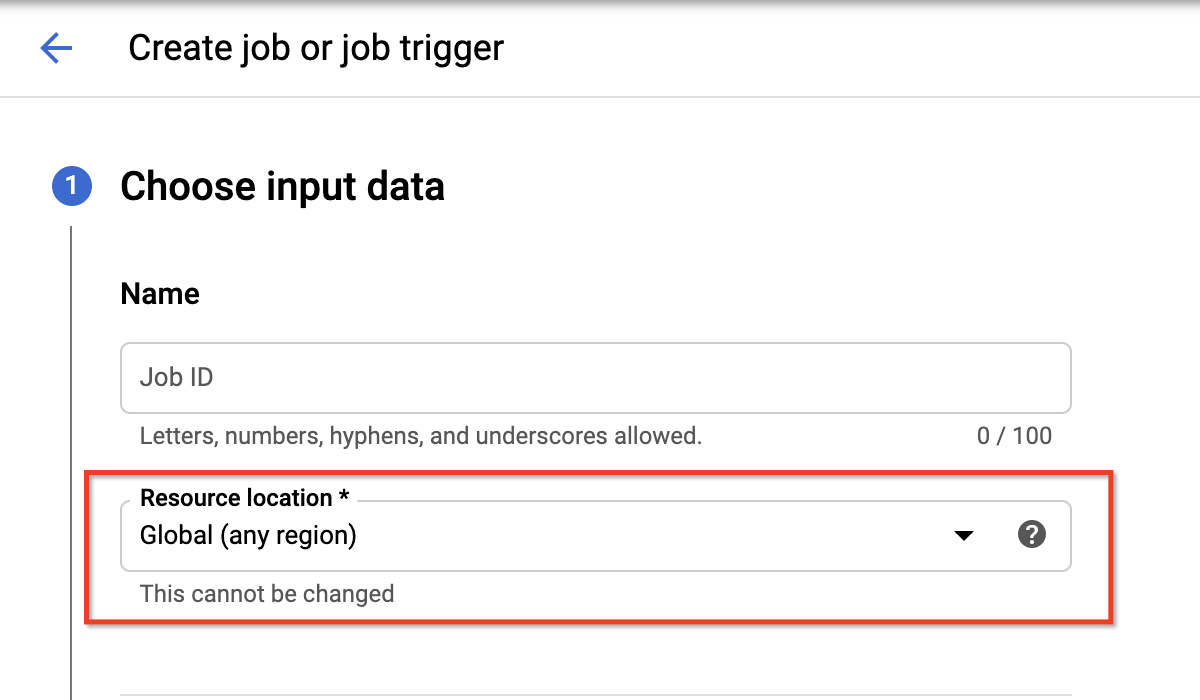您可以指定執行機密資料保護作業的地區,控管可能含有機密資訊的資料處理位置。本文說明 Sensitive Data Protection 處理位置的概念,並示範如何指定區域。
如要查看支援的單一地區與多地區清單,請參閱「敏感資料保護位置」一文。
關於區域和多區域
「地區」是特定的地理位置,例如美國西部或東北亞。「多區域位置」 (或簡稱「多區域」) 是指包含兩個以上地理區域的大型地理區域,例如歐盟。
位置注意事項
適合的位置可讓您在延遲時間、可用性和頻寬費用之間取得平衡。
使用單一區域可讓延遲時間和網路頻寬達到最佳化。
如果您要處理來自 Google 網路外部且分布在較大地理區域的資料,或者需要跨區域備援帶來更高的可用性,請使用多地區。
通常,您應該在方便的位置或包含大多數資料使用者的位置處理資料。
如果貴機構必須將傳輸中資料保留在指定位置,請只使用支援區域端點 (REP) 的區域或多區域。在這種情況下,您需要使用 Cloud Data Loss Prevention API,因為機密資料保護服務的區域端點無法搭配Google Cloud 控制台使用。
指定區域
指定處理區域的方式取決於您傳送要求的端點類型,也就是全域端點或區域端點。選擇端點類型時,請考量是否必須將傳輸中資料保留在特定區域。詳情請參閱「Sensitive Data Protection 的全域和區域端點」。
在對全球端點的要求中指定區域
控制台
設定 Sensitive Data Protection 作業時,請選擇區域。
舉例來說,建立工作觸發條件時,請從「資源位置」選單中選擇位置,如下所示:

如果不在意處理作業地點,請使用「全球」區域,Google 會選擇處理作業地點。預設區域為「全球」。
REST
在要求端點網址中插入區域資訊。如果不在意處理作業地點,請使用 global 地區,Google 會選擇處理作業地點。請注意,要求指定 global 地區建立的任何資源,都會儲存在 global 地區。
以下是向全域端點發出的部分要求範例。
使用全域區域
以下兩個要求的效用相同。不納入區域與指定 locations/global/ 的效果相同。
POST https://www.googleapis.com/dlp/v2/projects/PROJECT_ID/locations/global/content:inspect
POST https://www.googleapis.com/dlp/v2/projects/PROJECT_ID/content:inspect
使用特定區域
如要指定處理作業的區域,請在資源網址中插入 locations/,然後插入區域名稱。
POST https://www.googleapis.com/dlp/v2/projects/PROJECT_ID/locations/us-west2/content:inspect
在對區域端點的要求中指定區域
控制台
對於 Sensitive Data Protection,區域端點無法與 Google Cloud 控制台搭配使用。
C#
如要瞭解如何安裝及使用 Sensitive Data Protection 的用戶端程式庫,請參閱這篇文章。
如要驗證 Sensitive Data Protection,請設定應用程式預設憑證。 詳情請參閱「為本機開發環境設定驗證」。
Go
如要瞭解如何安裝及使用 Sensitive Data Protection 的用戶端程式庫,請參閱這篇文章。
如要驗證 Sensitive Data Protection,請設定應用程式預設憑證。 詳情請參閱「為本機開發環境設定驗證」。
Java
如要瞭解如何安裝及使用 Sensitive Data Protection 的用戶端程式庫,請參閱這篇文章。
如要驗證 Sensitive Data Protection,請設定應用程式預設憑證。 詳情請參閱「為本機開發環境設定驗證」。
REST
下列範例會將 content.inspect 要求傳送至區域端點。
與這項要求相關聯的任何資料,在傳輸、使用中和靜態期間,都會保留在指定區域。
使用任何要求資料之前,請先替換以下項目:
-
:提供 Sensitive Data Protection 區域端點 (REP) 的區域,例如
us-west2。REP_REGION如需完整地區清單,請參閱「Sensitive Data Protection 地區」。 -
PROJECT_ID:您的 Google Cloud 專案 ID。專案 ID 為英數字串,例如example-project。
HTTP 方法和網址:
POST https://dlp.REP_REGION.rep.googleapis.com/v2/projects/PROJECT_ID/locations/REP_REGION/content:inspect
JSON 要求主體:
{
"inspectConfig": {
"infoTypes": [
{
"name": "CREDIT_CARD_NUMBER"
}
]
},
"item": {
"value": "hi, my ccn is 4111111111111111"
}
}
如要傳送要求,請展開以下其中一個選項:
您應該會收到如下的 JSON 回應:
{
"result": {
"findings": [
{
"infoType": {
"name": "CREDIT_CARD_NUMBER",
"sensitivityScore": {
"score": "SENSITIVITY_HIGH"
}
},
"likelihood": "LIKELY",
"location": {
"byteRange": {
"start": "14",
"end": "30"
},
"codepointRange": {
"start": "14",
"end": "30"
}
},
"createTime": "2024-08-09T19:54:13.348Z",
"findingId": "2024-08-09T19:54:13.352163Z4747901452516738787"
}
]
}
}主機代管注意事項
掃描 Cloud Storage 或 BigQuery 等儲存空間存放區時,您應在 Sensitive Data Protection 要求中指定與要掃描的存放區相同的位置。舉例來說,如果 BigQuery 資料集位於歐盟多地區位置,請在設定 Sensitive Data Protection 工作時,指定歐盟多地區 (europe)。
如果未將機密資料保護要求與掃描的儲存空間存放區放在同一位置,系統可能會在資料位置和要求中指定的位置之間,分割處理要求。
後續步驟
- 進一步瞭解地理位置與區域。
- 查看支援的地區和多重地區清單。
- 進一步瞭解 Sensitive Data Protection 的全球和區域端點。

